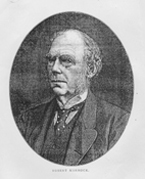Robert Marnock
Robert Marnock (1800–1889) was a renowned British horticulturist and garden designer, best known for his innovative work in the development of public gardens and parks during the 19th century. Marnock's contributions to horticulture and garden design have left a lasting legacy, influencing the layout and aesthetic of public green spaces well into the modern era.
Early Life and Education[edit | edit source]
Robert Marnock was born in 1800 in Scotland. Little is documented about his early life and education, but it is known that he developed a passion for plants and gardening from a young age. This passion would guide his career path and lead him to become one of the most influential garden designers of his time.
Career[edit | edit source]
Marnock's career in horticulture began in earnest when he took up a position at the Royal Botanic Gardens, Kew, where he gained valuable experience in plant cultivation and garden maintenance. His skills and innovative ideas quickly set him apart from his contemporaries.
In 1831, Marnock moved to Sheffield, where he was appointed as the head gardener at the Sheffield Botanical Gardens. It was here that Marnock's talents truly shone. He designed the gardens in a naturalistic style, moving away from the formal, geometric layouts that were popular at the time. His designs incorporated winding paths, varied plantings, and the use of natural landscapes to enhance the beauty of the gardens. This approach was revolutionary and would influence garden design for generations.
Marnock's work in Sheffield established his reputation as a leading garden designer. He went on to design several other notable gardens and parks, including the Weston Park in Sheffield and the Regent's Park in London. His designs often featured innovative use of plant species, creating rich, diverse environments that appealed to both the casual visitor and the botanical enthusiast.
Philosophy and Influence[edit | edit source]
Marnock's design philosophy centered around the idea that gardens should mimic the beauty and randomness of nature, rather than adhering to strict, man-made geometries. He believed in creating spaces that were not only beautiful but also functional and accessible to the public. This philosophy was somewhat radical at the time but has since become a foundational principle in landscape architecture.
Marnock's influence on garden design is still evident today. His work paved the way for the development of public parks and gardens as spaces for recreation and relaxation, accessible to all members of society. His designs emphasized the importance of green spaces in urban environments, a concept that is increasingly relevant in today's world.
Legacy[edit | edit source]
Robert Marnock passed away in 1889, but his legacy lives on through the parks and gardens he designed, many of which are still enjoyed by the public today. His contributions to horticulture and landscape architecture have been recognized by various historical and gardening societies, ensuring that his innovative work and philosophy continue to inspire future generations.
See Also[edit | edit source]
Search WikiMD
Ad.Tired of being Overweight? Try W8MD's physician weight loss program.
Semaglutide (Ozempic / Wegovy and Tirzepatide (Mounjaro / Zepbound) available.
Advertise on WikiMD
|
WikiMD's Wellness Encyclopedia |
| Let Food Be Thy Medicine Medicine Thy Food - Hippocrates |
Translate this page: - East Asian
中文,
日本,
한국어,
South Asian
हिन्दी,
தமிழ்,
తెలుగు,
Urdu,
ಕನ್ನಡ,
Southeast Asian
Indonesian,
Vietnamese,
Thai,
မြန်မာဘာသာ,
বাংলা
European
español,
Deutsch,
français,
Greek,
português do Brasil,
polski,
română,
русский,
Nederlands,
norsk,
svenska,
suomi,
Italian
Middle Eastern & African
عربى,
Turkish,
Persian,
Hebrew,
Afrikaans,
isiZulu,
Kiswahili,
Other
Bulgarian,
Hungarian,
Czech,
Swedish,
മലയാളം,
मराठी,
ਪੰਜਾਬੀ,
ગુજરાતી,
Portuguese,
Ukrainian
Medical Disclaimer: WikiMD is not a substitute for professional medical advice. The information on WikiMD is provided as an information resource only, may be incorrect, outdated or misleading, and is not to be used or relied on for any diagnostic or treatment purposes. Please consult your health care provider before making any healthcare decisions or for guidance about a specific medical condition. WikiMD expressly disclaims responsibility, and shall have no liability, for any damages, loss, injury, or liability whatsoever suffered as a result of your reliance on the information contained in this site. By visiting this site you agree to the foregoing terms and conditions, which may from time to time be changed or supplemented by WikiMD. If you do not agree to the foregoing terms and conditions, you should not enter or use this site. See full disclaimer.
Credits:Most images are courtesy of Wikimedia commons, and templates Wikipedia, licensed under CC BY SA or similar.
Contributors: Prab R. Tumpati, MD

